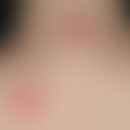Synonym(s)
HistoryThis section has been translated automatically.
DefinitionThis section has been translated automatically.
Seizure-like, usually symmetrical, but also asymmetrical or isolated, functional, digital vasospasms accompanied by numbness (affecting 45% of patients), tingling paraesthesia (in 20% of patients) and pain (in 60% of patients), which may be primarily idiopathic or secondary and may be relieved by the application of heat or medication.
The term "Raynaud's phenomenon" is synonymous with "Raynaud's syndrome" and does not require a separate definition.
You might also be interested in
ClassificationThis section has been translated automatically.
Primary Raynaud's syndrome (> 50 %) - conceptually the same as Raynaud's disease. Vasospasms of the fingers triggered by cold and emotional stress lasting up to 30 minutes.
Secondary Raynaud's syndrome (Raynaud's phenomenon): similar symptoms with symmetrical/asymmetrical involvement, usually associated with diseases from the group of so-called collagenoses.
Paraneoplastic Raynaud's syndrome also belongs to this group. It is associated with lung carcinomas and carcinomas of the ovaries and uterus (Lai TS et al. 2020; Lokineni S et al. 2021).
Occurrence/EpidemiologyThis section has been translated automatically.
The prevalence in the German population is approx. 8-10 %; in Sweden approx. 20 %, in Switzerland approx. 20-30 %.
EtiopathogenesisThis section has been translated automatically.
Vasospasms triggered by cold, emotional stress, local compression phenomena.
ManifestationThis section has been translated automatically.
Occurs between the ages of 20 and 50 (on average 36 years). It is rare for the first manifestations to occur in childhood or after the age of 65. Women are affected five times more frequently than men.
LocalizationThis section has been translated automatically.
Digiti II-V of the hand are mainly affected, more rarely also the toes. The thumbs are usually left out, as are the back of the hand and palms.
ClinicThis section has been translated automatically.
Mostly bilateral seizure symptoms with inital cyanosis, followed by seizure-like white coloration, which turns into excessive redness. In 1/3 of patients, however, there is only a seizure-like cyanosis or only a white discoloration of the fingers.
Differential diagnosisThis section has been translated automatically.
Permanent acral ischemia without seizure character must be distinguished.
Embolism (duration of ischemia > 30 min.)
PAVK (DD and one of the causes of secondary Raynaud's syndrome)
Isolated acrocyanosis (painless, never attack-like cyanotic discoloration of the fingers)
Systemic sclerosis of the acroscleroderma type (in addition to vasospasms of the fingers, extensive digital swelling and indurations, sclerotic nail folds, other signs of PSS with antibody detection/centromere-Ak; SCL70-Ak)
General therapyThis section has been translated automatically.
- Clarification and, if necessary, treatment of an existing underlying disease; otherwise symptom and phase-oriented prophylactic measures: protection from exposure to cold, wearing warm clothing, possibly also use of pocket warmers or heated gloves.
- Smoking ban (vasoconstrictor effect of nicotine)
- No prescription of drugs containing clonidine, ergotamine or epinephrine
- Physiotherapy: Robotic measures such as alternating warm hand baths, alternating between room temperature (not too cold!) and 37 °C. Alternatively, finger exercises, e.g. fango kneading or kneading warmed millet (whole grains!) with a few drops of olive oil.
- For some patients, it is also possible to increase the finger temperature through bio-feedback exercises or autogenic training.
Remember! Physical therapies such as alternating warm hand baths, fango kneading or kneading warm millet are helpful for Raynaud's symptoms!
External therapyThis section has been translated automatically.
Isosorbide dinitrate ointment (formerly: Isoket ointment): This has been withdrawn from the market, therefore Rectogesic according to chronic anal fissure, see there, or as an alternative preparation magistral formulation with diltiazem 2 % as cream (NRF 5.7) or gel (NRF 5.6). The vasodilator creams can lead to a reduction in blood pressure and headache, although less pronounced than with systemic vasomodulating therapy. Use as a monotherapeutic agent or in addition to internal therapy.
For minor injuries, early disinfectant measures such as polyvidone-iodine (e.g. Braunovidon ointment).
Warm kerosene baths of the hands are perceived as pleasant (note: a simple and inexpensive paraffin-containing body oil is sufficient for this; bathing time 5-8 minutes).
Internal therapyThis section has been translated automatically.
- Use of vasoactive substances:
- Calcium antagonists (considered the gold standard): Therapy of first choice is nifedipine (e.g. Adalat 5) 10-20 mg 3x / day p.o. as monotherapy or in combination with pentoxifylline (e.g. Trental) 600 mg / day p.o.; increase the nifedipine dose up to 3-4x / day 10 mg p.o. Caution! Orthostatic dysregulation with nifedipine! Long-term administration of pentoxifylline promotes skin bleeding!
- Alternatively diltiazem (e.g. Dilzem Tbl.) 60-120 mg / day p.o. or verapamil (e.g. Isoptin 80) 240-320 mg / day p.o.
- Other possible treatment regimens:
- ACE inhibitors and angiotensin-1 receptor antagonists: Several studies with the ACE inhibitors captopril (25 mg / day) and enalapril (20 mg / day) showed partly good and partly contradictory results. Losartan (angiotensin-1 receptor antagonist) had a comparable effect to 40 mg nifedipine/day in a randomized study.
- Alpha-1 receptor blockers: prazosin (e.g. Minipress) initially 1 mg p.o. at night, possibly additionally in the morning, slowly increasing to a maintenance dose of 4 mg / day.
- Prostacyclins (evidence level A): e.g. iloprost (Ilomedin) 0.5-2.0 ng/kg bw/min. The recommended daily infusion duration is 6-8 hours. Duration of therapy: 3-5 days. Therapy cycles are repeated after 3 months.
- Prostavasin (data situation unclear): For manifest or imminent gangrene! Effective but costly procedure to improve acral blood circulation. Dosage: Prostaglandin E1 (e.g. Prostavasin) 20 μg / hour i. v. over 3 hours.
- Estrogens: If symptoms worsen during menses and in the menopause, peroral administration of estrogens (e.g. Trisequens) by a gynecologist.
- Endothelin antagonists(bosentan): Promising approach, currently in multicenter study. Dosage: Tracleer 2x / day 125 mg p.o.
- PDE-5 inhibitors: In severe cases of refractory acral ulcerations, therapy with oral sildenafil (Viagra) at a dosage of 20-80 mg / day may be considered. In individual cases, iloprost can be combined with sildenafil.
Operative therapieThis section has been translated automatically.
Partial sympathectomy (previously the treatment of choice) is no longer used, favorable effect in 25 % of cases.
TablesThis section has been translated automatically.
Contributory causes of secondary Raynaud's syndrome:
- Connective tissue diseases
- Progressive systemic scleroderma, rheumatoid arthritis, systemic lupus erythematosus, Sjögren's syndrome, dermatomyositis/polymyositis
- Arterial occlusive diseases
- Arteriosclerosis, Endangiitis obliterans, Polyarteritis nodosa, Embolisms, Thromboses
- Shoulder girdle arm syndromes
- Cervical rib syndrome, 1st rib syndrome, scalenus syndrome, costoclavicular syndrome, hyperabduction syndrome, pectoralis minor syndrome, malposition syndrome, narrow upper thoracic aperture syndrome, Klippel-Feil syndrome, combination forms
- Hematogenous diseases
- Cold agglutinins, cold hemolysins, cryoglobulinemia, macroglobulinemia (Waldenström), paroxysmal hemoglobulinuria, hyperviscosity syndrome, thrombocytosis, polycythemia, thrombotic microangiopathy
- Neurological diseases
- Neuritis, poliomyelitis, multiple sclerosis, syringomyelia, nucleus pulposus prolapse, spinal tumors, carpal tunnel syndrome, hemiplegia
- Intoxications
- ergot alkaloids (ergotism), fungal toxins (folding tintling), vinyl chloride derivatives (vinyl chloride disease), trichloroethylene
- Chronic occupational trauma
- Vibration syndromes when working with jackhammers, power saws, walking on crutches, etc.
- Trauma
- Local vascular injuries, post-traumatic, cold damage
- Medicinal
- Clonidine, sympathomimetics, ACE inhibitors, hormonal anticonceptives, beta receptor blockers, secale alkaloids (ergotism), bleomycin, vincristine, ciclosporin
- Other
- surgery, Sudeck's atrophy, dialysis
Phytotherapy externalThis section has been translated automatically.
From a naturopathic point of view, ofiizine rosemary oil is recommended, which is applied to the affected hands several times a day as an externum (by Schoen-Angerer T et al. 2018).
LiteratureThis section has been translated automatically.
- Belch J et al. (2017)ESVM guidelines - the diagnosis and management of Raynaud's phenomenon.Vasa 46:413-423.
- Bowling JC et al (2003) Raynaud's disease. Lancet 361: 2078-2080
- Caccavo D et al (2003) Raynaud's phenomenon and antiphospholipid antibodies in systemic lupus erythematosus: is there an association? Ann Rheum Dis 62: 1003-1005
- Coffmann JD et al (1989) International study of ketanserin in Raynaud's phenomenon. Am J Med 87: 264-268
- Cohen LE et al (1989) Prostaglandin infusion therapy for intermittent digital ischemia in a patient with mixed connective disease. Case report and review of the literature. J Am Acad Dermatol 20: 893-897.
- Hummers LK et al (2003) Management of Raynaud's phenomenon and digital ischemic lesions in scleroderma. Rheum Dis Clin North Am 29: 293-313.
- Kallenberg CG et al (1987) Nifedipine in Raynaud's phenomenon: relationsship between immediate, short term and longterm effects. J Rheumatol 14: 284-290
Lai TS et al (2020) Paraneoplastic Raynaud's phenomenon associated with metastatic ovarian cancer: A case report and review of the literature. Gynecol Oncol Rep 33:100575
Lokineni S et al (2021) Paraneoplastic Raynaud's phenomenon as an initial manifestation of lung cancer? Eur J Case Rep Intern Med 8:002690
- Mayser P et al (2003) Persistent skin reaction and Raynaud's phenomenon after a sting by Echiichthys draco (great weever fish). Dermatologist 54: 633-637
- Raynaud AGM (1862) De l?asphyxie locale et de la gangrène symétrique des extrémités. Doctoral thesis, Rignoux, Paris
- Raynaud M (1888) On asphyxia and symmetrical gangrene of the extremities 1862 and new researches on the nature and treatment of local asphyxia of the extremities 1874. Translated by T. Barlow In: Selected Monographs, New Sydenham Society, London, pp. 1-199.
- Riemekasten G (2005) Recommendations of the German Society of Rheumatology for the treatment of Raynaud's syndrome and acral ulcerations. Z Rheumatol 64: 90-102
- Sunderkötter C et al (2006) Raynaud's phenomenon in dermatology. Dermatol 57: 927-942
- Suter LG et al (2005) The incidence and natural history of Raynaud's phenomenon in the community. Arthritis Rheum 52: 1259-1263
- Von Schoen-Angerer T et al (2018) Effect of topical rosemary essential oil on Raynaud's phenomenon in systemic sclerosis.Complement Ther Med 40:191-194.
Incoming links (21)
Carboplatinum; Crest syndrome; Cryofibrinogenesis; Cryoglobulins and skin; Cryoproteinemia; Digitus mortuus; Endotheline; Huriez syndrome; Knock-knock disease; Mixed connective tissue disease; ... Show allOutgoing links (12)
Autogenic training; Bosentan; Calcium antagonists, side effects; Centromere antibody; Estrogens; Iloprost; Pentoxifylline; Povidone-iodine; Raynaud's disease; Scl-70 antibody; ... Show allDisclaimer
Please ask your physician for a reliable diagnosis. This website is only meant as a reference.








